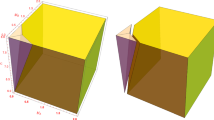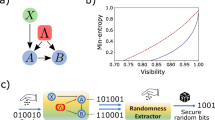Abstract
Device-independent (DI) randomness generations based on tilted CHSH Bell tests, different from other Bell tests, use a little entanglement but can produce quite a lot of certified randomness. In all these protocols, the violations of Bell inequalities which imply the generation of certified randomness rely on an assumption, i.e., measurement independence. Since ensuring measurement independence in a practical Bell test is difficult, it is crucial to explore effects of relaxing this assumption (called as measurement dependence). Naturally, a question, how measurement dependence affects tilted CHSH Bell tests, arise. In this paper, we answer this question. Concretely, we introduce measurement dependence with flexible lower bounds which are different from fixed lower bound and then qualify the effect of measurement dependence on tilted CHSH Bell tests with different input distributions. The results show that the effect of measurement dependence on tilted CHSH Bell tests with flexible lower bound of measurement dependence is more powerful than that of only considering fixed lower bound. The relevance of this work highlights the study of DI randomness amplification and other DI quantum information tasks.







Similar content being viewed by others
Explore related subjects
Discover the latest articles, news and stories from top researchers in related subjects.References
Popescu, S., Rohrlich, D.: Quantum nonlocality as an axiom. Found. Phys. 24(3), 379–385 (1994)
Barrett, J., Linden, N., Massar, S., Pironio, S., Popescu, S., Roberts, D.: Nonlocal correlations as an information-theoretic resource. Phys. Rev. A 71, 022101 (2005)
Gallego, R., Würflinger, L.E., Acín, A., Navascués, M.: Quantum correlations require multipartite information principles. Phys. Rev. Lett. 109, 070401 (2012)
Christensen, B.G., Liang, Y.C., Brunner, N., Gisin, N., Kwiat, P.G.: Exploring the limits of quantum nonlocality with entangled photons. Phys. Rev. X 5, 041052 (2015)
Ekert, A.K.: Quantum cryptography based on Bells theorem. Phys. Rev. Lett. 67, 661–663 (1991)
Acín, A., Gisin, N., Masanes, L.: From Bell’s theorem to secure quantum key distribution. Phys. Rev. Lett. 97, 120405 (2006)
Vazirani, U., Vidick, T.: Fully device-independent quantum key distribution. Phys. Rev. Lett. 113, 140501 (2014)
Jakobi, M., Simon, C., Gisin, N., Bancal, J.D., Branciard, C., Walenta, N.: Practical private database queries based on a quantum-key-distribution protocol. Phys. Rev. A 83, 022301 (2011)
Gao, F., Liu, B., Huang, W., Wen, Q.Y.: Postprocessing of the oblivious key in quantum private query. IEEE J. Sel. Top. Quant. 21, 6600111 (2015)
Wei, C.Y., Wang, T.Y., Gao, F.: Practical quantum private query with better performance in resisting joint-measurement attack. Phys. Rev. A 93, 042318 (2016)
Wei, C.Y., Cai, X.Q., Liu, B., Wang, T.Y., Gao, F.: A generic construction of quantum-oblivious-key-transfer-based private query with ideal database security and zero failure. IEEE Trans. Comput. 99, 2–8 (2018)
Liu, B., Gao, F., Wei, C., Wen, Q.Y.: Qkd-based quantum private query without a failure probability. Sci. China Phys. Mech. Astron. 58, 100301 (2015)
Pironio, S., Acín, A., Massar, S., Giroday, A.B.D.L., Matsukevich, D.N., Maunz, P.: Random numbers certified by Bell’s theorem. Nature 464, 1021 (2010)
Pironio, S., Massar, S.: Security of practical private randomness generation. Phys. Rev. A 87, 012336 (2013)
Fehr, S., Ran, G., Schaffner, C.: Security and composability of randomness expansion from Bell inequalities. Phys. Rev. A 87, 012335 (2013)
Hall, M.J.W.: Local deterministic model of singlet state correlations based on relaxing measurement independence. Phys. Rev. Lett. 105, 250404 (2010)
Hall, M.J.W.: Relaxed Bell inequalities and Kochen–Specker theorems. Phys. Rev. A 84, 022102 (2011)
Koh, D.E., Hall, M.J., Pope, J.E., Marletto, C., Kay, A.: Effects of reduced measurement independence on Bell-based randomness expansion. Phys. Rev. Lett. 109, 160404 (2012)
Thinh, L.P., Sheridan, L., Scarani, V.: Bell tests with min-entropy sources. Phys. Rev. A 87, 062121 (2013)
Pope, J.E., Kay, A.: Limited measurement dependence in multiple runs of a Bell test. Phys. Rev. A 88, 032110 (2013)
Pütz, G., Rosset, D., Barnea, T.J., Liang, Y.C., Gisin, N.: Arbitrarily small amount of measurement independence is sufficient to manifest quantum nonlocality. Phys. Rev. Lett. 113, 190402 (2014)
Yuan, X., Cao, Z., Ma, X.: Randomness requirement on the Clauser–Horne–Shimony–Holt Bell test in the multiple-run scenario. Phys. Rev. A 91, 032111 (2015)
Yuan, X., Zhao, Q., Ma, X.: Clauser–Horne Bell test with imperfect random inputs. Phys. Rev. A 92, 022107 (2015)
Li, D.D., Zhou, Y.Q., Gao, F., Li, X.H., Wen, Q.Y.: Effects of measurement dependence on generalized Clauser–Horne–Shimony–Holt Bell test in the single-run and multiple-run scenarios. Phys. Rev. A 94, 012104 (2016)
Colbeck, R., Renner, R.: Free randomness can be amplified. Nat. Phys. 8, 450 (2012)
Gallego, R., Masanes, L., De, L.T.G., Dhara, C., Aolita, L., Acín, A.: Full randomness from arbitrarily deterministic events. Nat. Commun. 4, 2654 (2013)
Brandão, F.G., Ramanathan, R., Grudka, A., Horodecki, K., Horodecki, M., Horodecki, P.: Realistic noise-tolerant randomness amplification using finite number of devices. Nat. Commun. 7, 11345 (2016)
Ramanathan, R., Brandão, F.G., Horodecki, K., Horodecki, M., Horodecki, P., Wojewódka, H.: Randomness amplification under minimal fundamental assumptions on the devices. Phys. Rev. Lett. 117, 230501 (2016)
Bancal, J.D., Gisin, N., Liang, Y.C., Pironio, S.: Device-independent witnesses of genuine multipartite entanglement. Phys. Rev. Lett. 106, 250404 (2011)
Barreiro, J.T., Bancal, J.D., Schindler, P., Nigg, D., Hennrich, M., Monz, T.: Demonstration of genuine multipartite entanglement with device-independent witnesses. Nat. Phys. 9, 559–562 (2013)
Bell, J.S.: On the Einstein Podolsky Rosen paradox. Physics 1, 3 (1964)
Bell, J.S., Aspect, A.: Speakable and Unspeakable in Quantum Mechanics: How to Teach Special Relativity. Cambridge University Press, Cambridge (2004)
Clauser, J.F., Horne, M.A., Shimony, A., Holt, R.A.: Proposed experiment to test local hidden-variable theories. Phys. Rev. Lett. 23, 880–884 (1971)
Wehner, S.: Tsirelson bounds for generalized Clauser–Horne–Shimony–Holt inequalities. Phys. Rev. A 73, 022110 (2006)
Acín, A., Massar, S., Pironio, S.: Randomness versus nonlocality and entanglement. Phys. Rev. Lett. 108, 100402 (2012)
Acknowledgements
The authors would like to thank the anonymous reviewers for their valuable suggestions. This work is supported by National Natural Science Foundation of China (Grant Nos. 61802023, 61701553), the Fundamental Research Funds for the Central Universities (Grant Nos. 2018RC21, 500418776), Joint Funds of National Natural Science Foundation of China and Xinjiang (Grant No. U1603261).
Author information
Authors and Affiliations
Corresponding author
Appendix
Appendix
1.1 Appendix A: the general input distributions
We show the deduction of Theorem 1.
Proof
Based on the lower bound and upper bound of measurement dependence, we get
where \(j,k\in \{0,1\}\).
For an arbitrary tuple \((X_{j},Y_{k},\lambda )\), let
The constrains on \(p'(X_{j}, Y_{k}|\lambda )\) can be converted to the following constrains:
where the last equality holds according to \(\sum _{j,k}p'(X_{j}, Y_{k}|\lambda )=1\).
So, we focus on the case that \(l=0\).
Let \(p_{A}(-1|X_{j},\lambda )=m_{j},\) \( p_{B}(-1|Y_{k},\lambda )=n_{k},\) \(p(-1,-1|X_{j},Y_{k},\lambda )=c_{j,k},\) we get
Hence, \(p(a, b|X_{j},Y_{k},\lambda )\in \{c_{j,k}, m_{j}-c_{j,k}, n_{k}-c_{j,k}, 1+c_{j,k}-m_{j}-n_{k}\}\).
As we know, \(c_{j,k}\) satisfies
where
Based on the definition of \(\langle X_{j}Y_{k}\rangle \), we get
So, by using Eqs. (24), (25), (26), we have
Thus, \(\widetilde{I}_{\alpha }^{\beta }\) can be described by
when the conditions \(m_{1}=0\) and \(n_{0}=n_{1}\) can be satisfied, “=” holds.
In the following, based on results of Ref. [18], we get the values of \(\min p(X_{j},Y_{k}|\lambda )\):
-
(a)
suppose that \(h\ge \frac{1}{3}\), we always find that \(\min p(X_{j},Y_{k}|\lambda )=0\).
-
(b)
if \(\frac{1}{4}\le h \le \frac{1}{3},\) let \(p(X_{j},Y_{k}|\lambda )=h\) except for \(p(X_{j_{1}},Y_{k_{1}}|\lambda )\) where \((j_{1},k_{1})\ne (j,k)\), so, \(\min p(X_{j},Y_{k}|\lambda )=p(X_{j_{1}},Y_{k_{1}}|\lambda )=1-3h\). Then, Eq. (28) can be given by
$$\begin{aligned} \begin{aligned}&\widetilde{I}_{\alpha }^{\beta }={\left\{ \begin{array}{ll} \beta +2\alpha +2, &{}\quad {h\ge \frac{1}{3}},\\ \beta +2\alpha +2-8(2G-1)(1-3h),&{}\quad {\frac{1}{4}\le h\le \frac{1}{3}}. \end{array}\right. } \end{aligned} \end{aligned}$$(29)
Next, \(I_{\alpha }^{\beta }\) can be reproduced as
Based on Eqs. (28), (30), we get the relation between \(I_{\alpha }^{\beta }\) and \(\widetilde{I}_{\alpha }^{\beta }\) in the following
Thus, we give the following results:
(a) when \(\frac{h-l}{1-4l}\ge \frac{1}{3}\), that is, \(3h+l\ge 1\), we get
(a) when \(\frac{h-l}{1-4l}< \frac{1}{3}\), that is, \(3h+l< 1\), we obtain
All in all, with flexible lower bounds of measurement dependence, we get
We complete proof of Theorem 1. \(\square \)
1.2 Appendix B: the factorizable input distributions
We show the deduction of Theorem 2.
Proof
The derivation process of \(\widetilde{I}_{\alpha }^{\beta }\) is similar to the proof of Theorem 1. Firstly, we still discuss the case that fixes lower bound.
Based on Eq. (28), we only compute the bound of \(\min p(X_{j},Y_{k}|\lambda )\) in the factorizable input distribution as follows.
-
(a)
Suppose that \(h\ge \frac{1}{2}\), we always find that \(l=\min p(X_{j},Y_{k}|\lambda )=0\).
-
(b)
If \(\frac{1}{4}\le h \le \frac{1}{2},\) we have
$$\begin{aligned} \begin{aligned} \min p\left( X_{j},Y_{k}|\lambda \right)&=\left( 1-\max p\left( X_{j}|\lambda \right) \right) \left( 1-\max p\left( Y_{k}|\lambda \right) \right) \\&=1-\max p\left( X_{j}|\lambda \right) -\max p\left( Y_{k}|\lambda \right) +h. \end{aligned} \end{aligned}$$(35)By computation, we get \(\min p\left( X_{j},Y_{k}|\lambda \right) =\frac{1}{2}-h\).
Then, Eq. (28) in the factorizable input distributions can be given by
Similar to the method of Theorem 1, we consider the case of flexible lower bound. By combining Eq. (36) with Eq. (31) , we get
We complete proof of Theorem 2. \(\square \)
Rights and permissions
About this article
Cite this article
Huang, XH., Li, DD. & Zhang, P. Effects of measurement dependence on tilted CHSH Bell tests. Quantum Inf Process 17, 291 (2018). https://doi.org/10.1007/s11128-018-2060-1
Received:
Accepted:
Published:
DOI: https://doi.org/10.1007/s11128-018-2060-1




